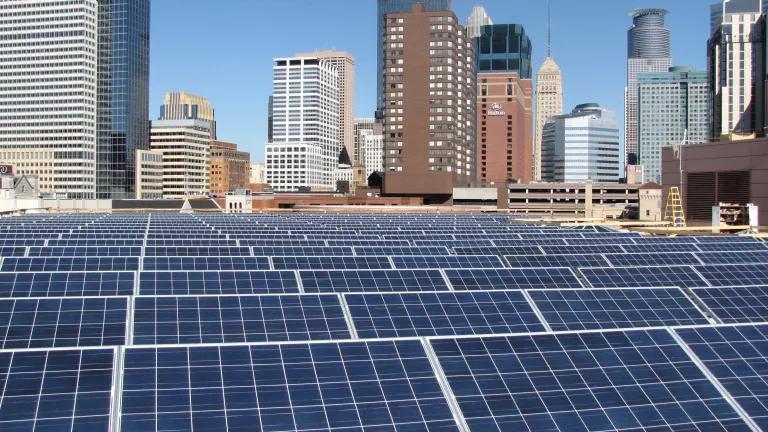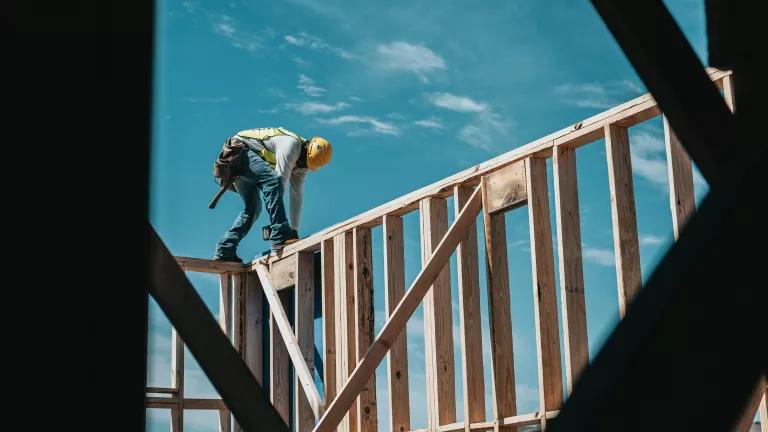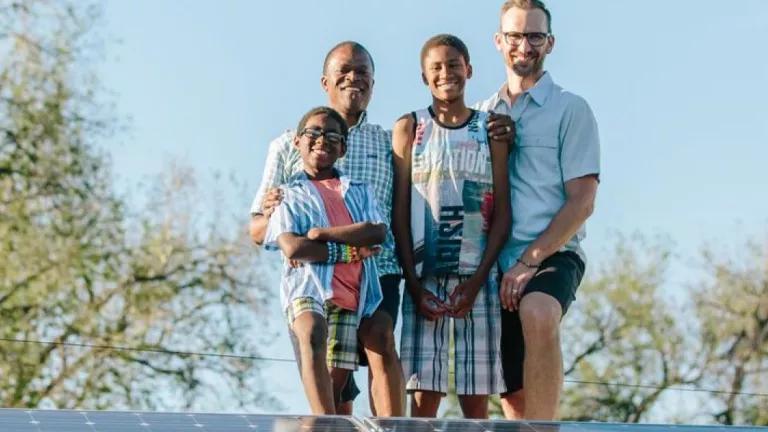Federal dollars from the new climate law, the Inflation Reduction Act (IRA), as well as the Bipartisan Infrastructure Law (BIL) have the potential to transform historically underinvested areas and dramatically advance climate action. Through tax credits, grants, rebates, incentives, and the creation of climate-focused programs, these two laws can supercharge our country’s transition to clean energy while improving the quality of life for millions across the country.
It is an exciting time in the climate and clean energy space as money is beginning to flow to the states, communities, and groups that will implement the funds. But how transformative this funding can be—and how much progress we can make toward a sustainable, resilient, and equitable future—will significantly depend on how ready states and local governments are to receive this money and put it to work.
A key program under the IRA is the U.S. Environmental Protection Agency’s (EPA) $27 billion Greenhouse Gas Reduction Fund (GGRF). This clean energy financing program—which recently announced its awardees—prioritizes investments in three critical sectors of our economy: renewable energy (distributed energy and storage), building decarbonization, and transportation, with a focus on delivering projects that benefit low-income and disadvantaged communities (as defined by the EPA). GGRF has the potential to transform the lives of millions across the country by driving more than $150 billion into communities that have struggled to access clean technologies and subsequently creating family-sustaining jobs, reducing energy bills, producing healthier indoor and outdoor air, and more.
NRDC designed the Federal Funds Readiness Tool for GGRF recipients (community lenders like green banks, credit unions, and community development financial institutions as well as state, local, and tribal governments), advocates, and policymakers to assess which states have policies in place for maximizing, and even multiplying, the impacts of GGRF. Partners can use this tool to gauge the potential readiness of each state to multiply the impact of GGRF and other IRA/BIL dollars while informing invested parties of the sectors they should be targeting for advocacy at the state or local level.
Strong state and local clean energy policies can expand the number of people that the IRA/BIL dollars can reach, and generate sustained, equitable impacts. NRDC’s Federal Funds Readiness Tool ranks states based on how ready their policy environments are across the three GGRF priority sectors: renewable energy (distributed energy and storage), building decarbonization, and transportation. To do this, we synthesized state policy scorecards from the American Council for an Energy-Efficient Economy (ACEEE), the Institute for Local Self-Reliance (ISLR), and NRDC’s own analysis. High-ranking states represent jurisdictions with policies that facilitate and/or promote additional investment in clean energy projects in these sectors (such as net metering or building performance standards), while states that lack such policies or have policies hostile to a clean energy economy (such as bans on utility energy efficiency programs) rank lower.
In the tool, users can view both how a state performs in each sector and the state’s total readiness across all three sectors. A key feature of the tool is the ability to change the weighting of sectors when looking at total state readiness. For example, a user prioritizing the building decarbonization sector could change that weight to 60 percent while weighting the distributed energy and transportation sectors at 20 percent each. This feature can be useful for GGRF recipients looking to see where states rank in relation to their portfolio of projects.
Assuming an equal weight across all three sectors, the states most ready for federal funds are:
1. California
2. Massachusetts
3. New York
4. Vermont
5. Oregon
In contrast, the states at the bottom are:
51. Alabama
50. Louisiana
49. South Dakota
48. Kansas
47. Wyoming
This ranking is not designed to guide funding. Instead, it is meant to show GGRF recipients the policy environment of the states they will be operating in while encouraging them, alongside other partners, to advocate for policies that complement federal funds.
Regardless of where a state may rank, GGRF recipients should be deploying funds to all communities across the country. For certain states, GGRF and other IRA/BIL programs may be the only decarbonization efforts in place, and avoiding deployment could lock vulnerable communities out of a critical opportunity to transition. In maximizing impact, NRDC urges GGRF recipients to act as both advocates and implementors. GGRF recipients can be important players in helping to shift the policy readiness of their states by partnering and collaborating with state-level advocates, environmental justice groups, community-based organizations, and state and local policymakers in pursuit of policies that unlock additional potential for GGRF dollars.
Key Enabling Policies
Among the policies included in the Federal Funds Readiness Tool are some that are more likely than others to generate additional financial and equity impacts around GGRF by growing the project pipeline, increasing the number of communities served, or being an additional lever in the financing of a project. These policies, organized by sector, are discussed below. We urge those in the GGRF ecosystem to pursue the strengthening or adoption of the following policies in the states they operate in while following the lead of community-based organizations and environmental justice groups.
Renewable energy (distributed energy and storage)
Renewable distributed energy resources comprise smaller renewable energy generation and storage technologies that produce less than 10 megawatts of power.
- Renewable portfolio standards with a distributed energy carve-out
Renewable portfolio standards (RPS) require that a specified percentage of the electricity that utilities sell comes from renewable resources. States can also establish a carve-out in their RPS, which sets a requirement for a portion of the overall renewable energy requirement to come from distributed energy sources (or other technology).
RPS is a critical driver of renewable project development. Since 2000, RPS policies have constituted 44 percent of total renewable electricity growth in the United States. RPS with distributed energy carve-outs can further accelerate the rate of renewable energy growth when paired with GGRF financing. - Community renewables enabling legislation with low-income provisions
Community renewables (such as community solar) allow customers to subscribe to a portion of electricity generated by an off-site distributed energy source through a community renewable provider. Utilities pay the provider for the energy generated, which in turn credits customers for the portion of electricity they subscribe to. Customers can apply these credits to their utility bills, lowering monthly payments.
Nearly 50 percent of households and businesses, usually located in disinvested communities, are unable to host rooftop solar systems because they are renters, don’t have the right rooftop conditions, or can’t afford a photovoltaic system. Community solar programs help these households access renewable energy. To further expand access to renewables, policies can also designate carve-outs and incentives or create specific programs to increase uptake in low-income communities.
Favorable and inclusive community renewable policies allow more people to benefit from distributed energy. In turn, these policies can increase the number of individuals who can benefit from GGRF distributed energy financing, as well as other IRA incentives. - Net metering
Net metering is a compensation structure that allows renewable energy owners to turn excess electricity they generate into credits that they can use to power their homes when a renewable energy source is not available.
Net metering is one of the main policy drivers behind solar adoption across the United States, and states that are implementing it could help make distributed generation projects that are financed by GGRF financially viable. - Interconnection
Interconnection standards are the guidelines that determine how renewable energy systems, energy storage, and other distributed energy resources connect to the grid.
Poorly designed or overly expensive interconnection procedures can make new energy projects seeking to connect to the grid, including projects potentially financed by GGRF capital, economically infeasible to complete.
Building decarbonization
Decarbonization comprises activities and programs that reduce greenhouse gas (GHG) emissions from buildings.
- Building Performance Standards
Building Performance Standards (BPS) require existing buildings to meet a GHG or energy performance target. These standards usually become more stringent over time.
Current rates of building retrofits are low, and existing energy efficiency programs, such as the Home Performance with Energy Star and the Weatherization Assistance Program, are not designed nor sufficient to meet net zero goals for the sector by 2050. BPS can be a key driver in increasing rates of building decarbonization.
Through the IRA, states and localities can apply for technical assistance funding to adopt and implement BPS. If BPS is adopted, it could drive building decarbonization project pipelines to GGRF awardees playing a role in financing its compliance. - Building energy codes
Building energy codes set minimum requirements for energy-efficient construction at the time of construction and major renovations. Having energy efficiency requirements during a new build can prevent costly and difficult retrofits later. New updates to building codes can significantly reduce energy use and, with the introduction of zero energy codes by the American Society of Heating, Refrigerating, and Air-Conditioning Engineers, eventually ratchet down toward meeting net zero goals.
IRA and BIL dollars are available to states and localities looking to update or adopt building energy codes/zero energy codes. GGRF recipients could expect pipeline growth by adopting the newest version of these building energy codes. - Equitable energy efficiency programs
Electric utilities can drive energy efficiency improvements in homes through programs, including financing programs that incentivize the adoption of high-efficiency appliances, fund workforce and development programs, promote building retrofits and code compliance, and more. Some utilities also run equitable energy efficiency programs that seek energy efficiency savings in disadvantaged communities.
Utilities can implement these programs voluntarily but often create them in response to state policies that set energy efficiency targets or explicitly require the creation of these incentives.
The growth of equitable energy efficiency programs can complement GGRF financing, as utility incentives could be stacked and braided with GGRF financing and other IRA financing to unlock additional beneficiaries of federal dollars.
Transportation
The transportation sector includes projects, technologies, or activities that support zero-emissions transportation modes such as electric vehicles, charging infrastructure, walking, and biking.
- Vehicles miles traveled (VMT) and GHG targets paired with spending on public transit, walking, and biking infrastructure
States can set goals for reductions in vehicle miles traveled (VMT) and/or GHG. These targets can incentivize more transportation choices for people, such as improving public transportation, creating safer infrastructure for biking and walking, and building mixed-use neighborhoods. Increasing investments in public transit, walking, and biking infrastructure are critical components of meeting these targets.
As potential financers of micromobility options and small-scale infrastructure to improve walkability and bikeability, GGRF recipients are suited to respond and benefit from VMT targets while complementing state and local investments. - Vehicle emissions standards
Vehicle emissions standards are regulatory requirements for electric vehicle (EV) adoption. Under the Clean Air Act, states can adopt the Advanced Clean Cars (ACC) rules set by California’s vehicle standards. The ACC rules collectively set statewide low- and zero-emission vehicle standards and require automakers to produce increasing numbers of new zero-emission vehicles each year.
Vehicle emissions standards will increase EV inventory for buyers, ultimately leading to increased levels of EV adoption, especially when paired with IRA programs such as the Clean Vehicle Tax Credits for new and used EVs. GGRF recipients can benefit from increased demand driven by EV standards as potential financiers of vehicles and EV-enabling technologies (such as charging stations).
Data
ACEEE: State Energy Efficiency Scorecard (2022)
ACEEE’s energy efficiency scorecard ranks states in six areas of state energy efficiency policy: utility programs, transportation, building energy codes, state initiatives, industrial energy efficiency, and appliance standards; this year’s scorecard also has an expanded focus on equitable policies.
ISLR: Community Power Scorecard (2024)
The ISLR’s Community Power Scorecard rates states based on how favorable their written policies are in helping to advance local clean energy action. ISLR scores states across 18 policies, including: net metering, third-party ownership, interconnection, hosting capacity analysis, community solar, community choice energy, franchise authority, gas ban pre-emption, renewable portfolio standards, integrated resource plan approval, inclusive utility investment, disconnection prevention, and right of first refusal.
NRDC: Getting Transportation Right: Ranking the States in Light of New Federal Funding (2023)
NRDC’s transportation report ranks states on their comprehensive plans to deliver sustainable and equitable transportation. NRDC scores states on 22 metrics, including: procurement practices, EV rebate programs, emissions reductions goals, road maintenance prioritization, and clean car standards.
ACEEE: Transportation Electrification Scorecard (2023)
ACEEE’s transportation scorecard ranks states on their efforts to electrify transportation and thereby reduce transportation-related carbon emissions. ACEEE scores states on their policies to scale up deployment of light-duty and heavy-duty EVs and on their progress in building the necessary charging infrastructure for personal, commercial, fleet, and public-transit EVs.
Interstate Renewable Energy Council (IREC) and Vote Solar: Freeing the Grid Scorecard (2023)
IREC and Vote Solar’s scorecard ranks states on specific policies that increase clean distributed energy adoption and access to the grid. As of March 2024, the scorecard only ranks states based on their interconnection policies and metrics, including rule applicability, streamlined review, modifications, timelines and efficiency, interconnection costs and requirements, updated standards and export provisions, initial review screens, supplemental review screens, data sharing and reporting, and dispute resolution.
NRDC used data from the Freeing the Grid scorecard in a previous version of the Federal Funds Readiness Tool. NRDC removed the data as ISLR recently updated their Community Power scorecard for 2024 and included Freeing the Gird scores as part of their total assessment for local clean energy action. To not be duplicative, we only use the aggregated ISLR scores.
Methodology
NRDC cleaned data from the above sources to create sector-specific scores for each state in the distributed energy and storage, building decarbonization, and transportation sectors. Using these scores, we calculated state-specific z-scores to rank states in the three sectors. The Federal Funds Readiness Tool then combines the z-scores across all three sectors to find a total “readiness” measurement for each state.
For the building decarbonization score, we utilized ACEEE’s State Energy Efficiency Scorecard but removed transportation scores to ensure the data only represent buildings-related policies. For distributed energy and storage sector scores, we utilized ISLR’s Community Power Scorecard. For transportation sector scores, we utilized NRDC’s Getting Transportation Right scorecard, except for Washington, D.C.'s score, which we pulled from ACEEE’s Transportation Scorecard. We specifically used Washington, D.C.’s z-score from ACEEE’s Transportation Scorecard, while we used z-scores based on NRDC’s Getting Transportation Right Scorecard for every other state.



